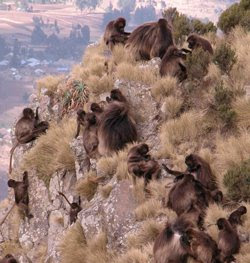
My dad forwarded an email to me that I couldn't resist sharing this way.
Apparently, during hurricane Hannah, two baby tigers were born at "TIGERS, The Institute of Greatly Endangered and Rare Species" in South Carolina. Their mother was too stressed, they said, so they separated the cubs and humans began caring for them — that is — until 2-yr-old chimp Anjana stepped in.

She feeds the babies milk with a bottle, lies with them, plays with them and in other ways acts as a surrogate mother.
But wait a second, aren't chimps notoriously really aggressive?
Yes, they hunt and kill monkeys to eat. They beat each other up as part of dominance struggles, and they stalk other chimp groups and kill them gang warfare style.

They are also very affectionate and as far as parenting goes, tend to be very attentive caregivers. Like humans, mama chimps differ in parenting styles and attentiveness. First time chimp mothers often don't seem to know what they're doing. They hold and carry the baby wrong. Fail to respond to cries. Accidentally sit on the babies - you name it. But, chimps who have babysitting practice, seem to get it. They are more attentive, more patient and also less likely to use aggressive ways of disciplining their babies.
For example, some mama chimps bite their babies during weening to get the babies to stop whining and begging to nurse. Others lay their chest down on the ground or cover their chest with their arms — a much more gentle solution to the problem.

Young chimps are fascinated by babies. Older siblings seek out their younger siblings to play with and practice parenting skills by babysitting them. And, evidence such as this case along with many others like it, suggest that chimps (like other apes like gorillas and humans) don't seem to care what species the baby is.
Koko, the gorilla who was taught sign language at an early age, had a pet kitten that she treated like a baby.
Of course, both of these young apes grew up learning from humans so that has something to do with it. Wild gorillas and wild chimps would never even have the chance to care for another species, but there are a few scattered reports I recall of juveniles accidentally coming across babies of other species. The reports indicate the instinct seems to be one more of curiosity than of murder.
**** Say it isn't so...Unsurprisingly, the chimp in this case appears to lack upper teeth, something that is not normal at this age. They may very well have been pulled, a practice routine with chimps used in show business. It makes them less dangerous to work with as they grow older and stronger.
Googling this TIGERS place, and reading their
website, makes it clear to me that it is very much like other fake animal sanctuaries that skirt the line of legality and ethics. Rather than being places of genuine research and sanctuary, they are in actuality roadside zoos and excuses to keep exotic animals as pets where laws prohibit it. They are not a non-profit organization. They don't list what percent or even exactly to whom they make charitable donations for conservation. At best, they merely educate people that wild animals can be trained to do extraordinary things.
In my opinion, they are scumbags who exploit animals.
The TIGERS website has a
page where they advertise the animals have appeared in commercials. "One of the series of commercials that our animal actors have starred in recently is for Schweppes Tonic Water," they proudly say.
Don't bother looking at their website to learn more about animals or even conservation, you won't find it. You'll find more educational value in reading one paragraph of a description of the felt monkeys I make and sell on etsy.
In any case, I'm glad you're reading this and hope you found value to it. You can probably guess that I'm pretty passionate about this stuff. I don't often come right out and call people scumbags, but when I do, I mean it.
Thanks for listening, and please do chime in with comments.
 Japan is famous for paper, but did you also know Japan produces some of the coolest patterns for making your own paper sculptures? I didn't until I found a kit to make a mountain gorilla in a nifty store in Japan. Today I stumbled on a website, sponsored by Yamaha (as in Yamaha Motors) that offers the patterns and instructions for FREE! All you need to do is download the PDFs, print, cut and assemble.
Japan is famous for paper, but did you also know Japan produces some of the coolest patterns for making your own paper sculptures? I didn't until I found a kit to make a mountain gorilla in a nifty store in Japan. Today I stumbled on a website, sponsored by Yamaha (as in Yamaha Motors) that offers the patterns and instructions for FREE! All you need to do is download the PDFs, print, cut and assemble.














.jpg)



.jpg)




.jpg)












.jpg)
.jpg)
.jpg)



.jpg)
.JPG)
.jpg)




